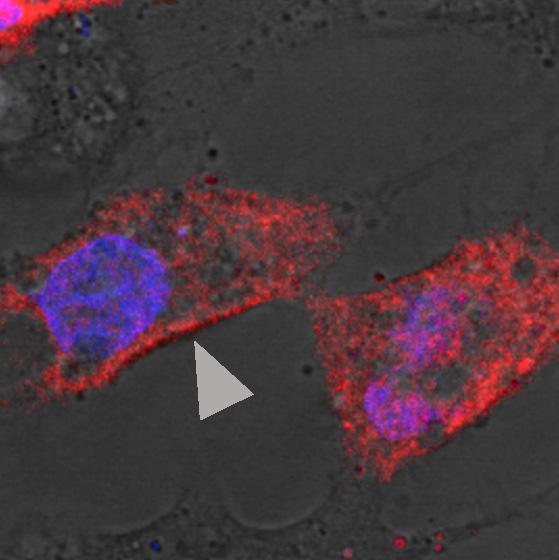NIH scientists illuminate causes of hepatitis b virus-associated acute liver failure

This image shows hepatitis B core antigen (arrow head) on the cellular membrane in cells transfected with hepatitis B virus. The virus is derived from a patient with acute liver failure. Credit: NIAID
By applying state-of-the-art technologies, the researchers discovered important new mechanisms about the disease by examining liver samples taken from four patients who developed HBV-ALF.
HBV-ALF is one of the most dramatic clinical syndromes in medicine, according to the research team, but so rare that samples of this type are seldom available for study.
Scientists from NIH's National Institute of Allergy and Infectious Diseases (NIAID) led the project with colleagues from two Italian universities. Their study is published in Proceedings of the National Academy of Sciences.
The investigators used advanced gene sequencing and tissue and cell analysis technologies to determine specific molecular events occurring at the site where HBV replicates and damages liver tissue. They identified processes that are distinct to HBV-ALF cases compared with cases of classic acute HBV infection.
Some of these unique events involve a highly mutated virus antigen, the HBV core antigen. The scientists believe that this antigen plays a key role in disease development because it interacts with specific antibodies that are–unusually, they say–already present in these patients.
Because of ethical reasons in obtaining liver tissues from patients with classic acute HBV, for their comparison study the scientists used archived liver specimens from two chimpanzees with acute HBV that had been studied many years earlier. They found the mechanism of acute HBV disease to be completely different from that of ALF.
According to the scientists, the HBV-ALF findings were consistent among samples taken from all four patients studied. That is important validation, they say, because virtually no studies have been done on the molecular pathogenesis of HBV-ALF in the liver. They hope their new work provides a model of how the disease develops and will lead to new diagnostic, treatment and prevention strategies.
###
ARTICLE:
Z Chen et al. Role of humoral immunity against hepatitis B virus core antigen in the pathogenesis of acute liver failure. Proceedings of the National Academy of Sciences DOI: 10.1073/pnas.1809028115 (2018).
WHO:
Patrizia Farci, M.D., of NIAID's Laboratory of Infectious Diseases, is available to comment on this study. Dr. Farci is chief of the Hepatic Pathogenesis Section.
CONTACT:
To schedule interviews, please contact Ken Pekoc, (301) 402-1663, kpekoc@niaid.nih.gov“>kpekoc@niaid.nih.gov.
NIAID conducts and supports research–at NIH, throughout the United States, and worldwide–to study the causes of infectious and immune-mediated diseases, and to develop better means of preventing, diagnosing and treating these illnesses. News releases, fact sheets and other NIAID-related materials are available on the NIAID website.
About the National Institutes of Health (NIH): NIH, the nation's medical research agency, includes 27 Institutes and Centers and is a component of the U.S. Department of Health and Human Services. NIH is the primary federal agency conducting and supporting basic, clinical, and translational medical research, and is investigating the causes, treatments, and cures for both common and rare diseases. For more information about NIH and its programs, visit http://www.
NIH…Turning Discovery Into Health®
Media Contact
All latest news from the category: Life Sciences and Chemistry
Articles and reports from the Life Sciences and chemistry area deal with applied and basic research into modern biology, chemistry and human medicine.
Valuable information can be found on a range of life sciences fields including bacteriology, biochemistry, bionics, bioinformatics, biophysics, biotechnology, genetics, geobotany, human biology, marine biology, microbiology, molecular biology, cellular biology, zoology, bioinorganic chemistry, microchemistry and environmental chemistry.
Newest articles

NASA: Mystery of life’s handedness deepens
The mystery of why life uses molecules with specific orientations has deepened with a NASA-funded discovery that RNA — a key molecule thought to have potentially held the instructions for…

What are the effects of historic lithium mining on water quality?
Study reveals low levels of common contaminants but high levels of other elements in waters associated with an abandoned lithium mine. Lithium ore and mining waste from a historic lithium…

Quantum-inspired design boosts efficiency of heat-to-electricity conversion
Rice engineers take unconventional route to improving thermophotovoltaic systems. Researchers at Rice University have found a new way to improve a key element of thermophotovoltaic (TPV) systems, which convert heat…



